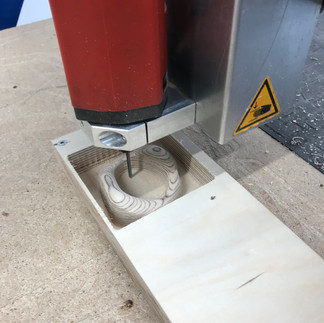CNC milling
- sophiefuhlbruegge
- Apr 29, 2022
- 2 min read
several sessions 2D, 3D
After an intensive artistic examination of wood as a material, a machine processing technique was searched for. At the university, it is possible to work with a CNC milling machine.
I had no previous experience with the technology, but I was able to build on the knowledge I had gained about wood in advance and also apply experience from the areas of laser cutting and 3D printing. For example, there are similarities in the axis movements of the machines, or calibrations such as zero points. I was trained 1:1 on the machine in several sessions and was able to benefit from the lab engineer‘s experience during the process.
First, a two-dimensional object was milled out. Only the organic object shape was milled out and a so-called pocket was also created. This served as a first exercise to familiarise oneself with the machine and technology.
In another session, an object was milled in 3D. The basis was a 3D sculpted object that was also 3D printed in the later process. For 3D milling, a 3D file is indispensable. There are many settings for operating the machine that have to be made in advance in the corresponding programme.
This process is much more extensive and involves a tool change. In the first step, the shape is roughly milled and a lot of material is removed. After a tool change to a finer milling head, the final shape is carved out. To mill the bottom side as well is technically very complex and difficult with the given machine preconditions, which is why I decided to carve and grind the second side by hand.
The technology is to be used for handbag handles and connecting elements of body bags, as well as for accessories. There will be a combination of handwork and machine work.















Comments